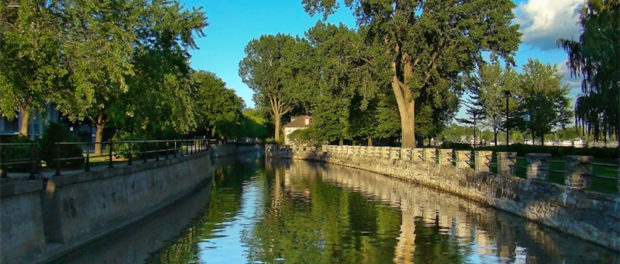1819-25: The Lachine Canal & Other Quebec Curios
Part of “The Canadas in Britain”, 1792-1827
Ideas to create a Lachine Canal go further back than the nineteenth century, but curiously enough, concrete plans to construct such a beneficial item to Montreal’s commercial sector would not happen before the 1800s. The idea was first and foremost a French-Canadian idea stemming from the late 1600s by local settlers who wanted to bypass a section of waters in the Saint Lawrence called the Lachine rapids, but whose plans were interrupted by a series of wars between the settlers and the Native Americans in Lachine. The Sulpician society that still had some power in Montreal in the 1700s had their own attempt to create a Lachine Canal as well but failed due to lack of funding.
The Lachine rapids, now a contemporary adrenaline rush for kayakers and river rafting, were so powerful and fast-moving that early explorers needed to get out of their boats and go on land, a manoeuvre called “portage”, to bypass this quite potentially deadly and costly area of water. Jacques Cartier had to stop his maritime explorations to get off here due to the rapid and choppy movement of the waters. Due to the frequency that portage needed to happen for exploration and trade, the explorers of New France established Lachine as both a resting stop and eventually a full-blown city.
It is not surprising, then, that merchants and bankers were the ones to initiate plans for a modern Lachine Canal. Lachine’s agriculture and fur were its main selling points, but the former rapidly overtook the latter in terms of importance. Wanting to make a name for the city, John Richardson, one of the founders of the Bank of Montreal as well as a merchant, allied with people who had similar interests to him to spearhead the initiative towards the construction of a canal with more tranquil, controlled waters that would enable a connection between Montreal to the trade routes of the Continent. Richardson and his seven colleagues had the capital to build a canal. With the help of engineer Thomas Burnett, they had the means and the plans to implement their vision.
Construction of the Canal officially began in July of 1821 and completed in 1825. Due to the Canal’s construction, people started to move towards Lachine instead of its neighbour LaSalle to be closer to where the work would be; with the Industrial Revolution just starting up, this population migration would prove useful to the city. After a series of expansions of the Canal in the 1840s and the 1870s, merchants would use the Lachine Canal until 1970, when the Canal was closed to commercial navigation after a long period of decline in ships due to the opening of the Saint Lawrence Seaway.






